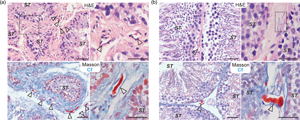Published online by Cambridge University Press: 07 October 2022

Telocyte (TC)—a new type of interstitial cell with long telopodes, can form cellular junctions with various tissues or cells to participate in the regulation of multitudes of physiological activities and diseases. This study aimed to characterize the morphology, molecular features, and potential functions of hormone regulation in Chinese soft-shelled turtle (Pelodiscus sinensis) testis TCs at different reproductive stages by histological evaluation, immunohistochemistry (IHC), immunofluorescence (IF), and transmission electron microscopy. During hibernation, TCs were widely distributed in the interstitial tissue. In contrast, during reproductive activity, TCs were noted to be in close proximity with peritubular myoid cells surrounding the seminiferous tubule. Moreover, formed cell–cell junctions were observed between TCs and PTMs. The results of IHC and IF showed that the immunophenotype of testicular TCs in hibernating Chinese soft-shelled turtles is CD34+Vimentin−, while the reproductive telopodes (Tps) show low expression of vimentin. The androgen receptor is expressed in Tps of TCs of testis during hibernation. Our results showed also that TCs in seasonal breeding animals regulate the activity of neighboring cells by releasing extracellular microvesicles (EXMVs), thus influencing the activity of spermatogenesis and steroidogenesis. Consideration of our novel and interesting results indicate that the whole area warrants further research.
These authors contributed equally.